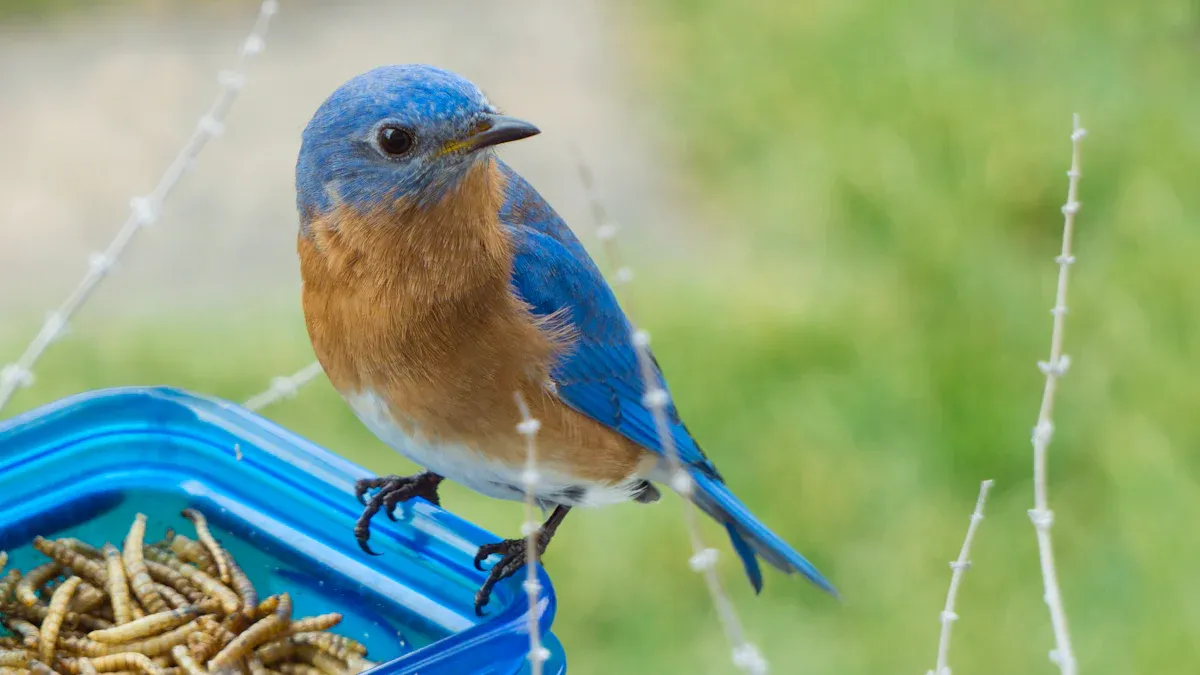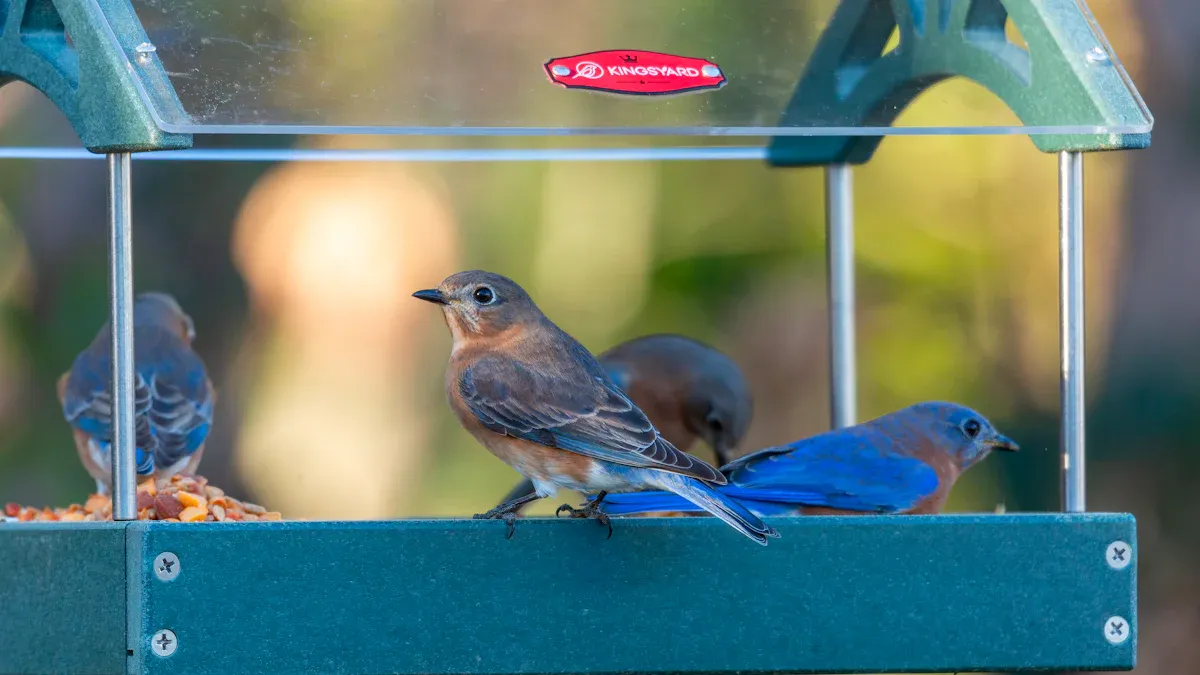
Birds in your backyard deserve the best. Mealworms offer them powerful nutrition. Discover how to enhance bird health with Bird Feed Mealworms. Learn essential strategies for feeding them in 2025. These tips will optimize backyard bird feeding for vitality.
Key Takeaways
- Mealworms give birds important protein and energy. They help birds grow, migrate, and stay warm in winter.
- Store mealworms correctly. Keep live ones in a cool place with bedding. Keep dried ones in a cool, dark, airtight container.
- Clean bird feeders often. This stops germs from spreading. It keeps birds healthy and safe.
Understanding the Nutritional Power of Bird Feed Mealworms
Why Mealworms are Essential for Birds
Mealworms are tiny powerhouses for birds! They pack a serious nutritional punch. Birds need these insects for strong muscles and quick repairs. For example, 100 grams of dried mealworms deliver about 50 grams of protein. This protein is vital for their growth. Mealworms also provide fat, which gives birds energy and keeps their feathers healthy. Fiber in mealworms helps with digestion, promoting overall gut health. Furthermore, these amazing insects are rich in B12 and B2 vitamins, which are crucial for energy. They also contain important minerals like iron, calcium, magnesium, and zinc. These minerals support strong bones and a robust immune system. Mealworms offer an outstanding balance of essential amino acids and fatty acids, supporting a bird’s overall health.
Benefits for Diverse Bird Species
Many different bird species absolutely adore mealworms! Bluebirds are famous for their love of these tasty treats. But they are not alone. Chickadees, titmice, thrushes, nuthatches, buntings, catbirds, orioles, robins, tanagers, flycatchers, grosbeaks, tits, warblers, and wrens also enjoy them. Mealworms are an excellent source of fiber, fat, and protein. These nutrients are crucial for birds during nesting, when they lay eggs, and when they raise their young. They also help birds during long migrations and when they survive harsh winter months. Eastern Bluebirds strongly prefer live mealworms. Wrens, primarily insect eaters, find mealworms a top choice, especially live ones during nesting season. American Robins happily eat live mealworms from feeders. Even Downy and Hairy Woodpeckers will snatch up mealworms! Northern Cardinals and Tufted Titmice also include mealworms in their varied diets.
Live vs. Dried Mealworms: A Comparison
When offering Bird Feed Mealworms, you have two main choices: live or dried. Both types offer great nutrition, but they have some differences.
| Mealworm Type | Protein Content |
|---|---|
| Dried | 53% |
| Live | 20% |
Dried mealworms boast a higher protein content by weight, as the water has been removed. Live mealworms, however, offer hydration and movement, which can be very enticing to birds. Some birds prefer the wiggling action of live mealworms, while others readily accept the dried variety. You can even rehydrate dried mealworms to make them more appealing.
Proper Sourcing and Storage for Bird Feed Mealworms
Where to Buy Quality Mealworms
Finding top-notch mealworms makes a big difference for your backyard birds. Look for reputable suppliers. Many pet stores offer live and dried options. Online retailers also provide excellent choices, often in bulk. Always check reviews and ensure the supplier focuses on quality and freshness. Good suppliers keep their mealworms healthy and well-fed. This means your birds get the best nutrition possible.
Storing Live Mealworms Safely
Live mealworms need a cozy home to stay fresh. Keep them in a smooth-sided container, like a plastic tub. Add a substrate such as oatmeal, cornmeal, or wheat bran. This gives them bedding and food. They thrive best in a comfortable environment. The ideal temperature for these wriggly treats is between 15°C and 30°C (60-86°F). Many find around 75°F perfect. Maintain humidity between 55-80%, with 70% being just right. This keeps them happy and healthy until your birds enjoy them.
Storing Dried Mealworms Effectively
Dried mealworms are super convenient. Proper storage keeps them fresh and nutritious. Always store them in a cool, dark place. An airtight container works best. This keeps out moisture and pests. Light can reduce their color and nutritional value, so a dark pantry is ideal. Keep them away from heat sources like stoves. For longer storage, especially in warm or humid areas, refrigeration is a great idea.
Tip for Long-Term Storage: Refrigeration extends the shelf life of dried mealworms significantly. It slows degradation and prevents mold. Use an airtight container and label it with the date. This keeps them fresh for up to a year or more! Regularly check your Bird Feed Mealworms for any signs of spoilage, like mold or strange smells.
Effective Feeding Methods for Bird Feed Mealworms

Best Feeders for Mealworms
Choosing the right feeder makes all the difference for your feathered friends. Birds love easy access to their treats! Shallow dishes or platform feeders work wonderfully for both live and dried mealworms. These feeders allow birds to see the tasty morsels clearly. For live mealworms, consider feeders with smooth sides or a slight lip. This keeps the wriggly snacks from escaping too quickly. Some specialized mealworm feeders even have small holes, letting only smaller birds access the goodies. This ensures everyone gets a fair share.
How to Offer Mealworms to Birds
Offering Bird Feed Mealworms is simple, but a few tricks help. Place feeders in open areas where birds feel safe from predators. They like to have a clear view around them. Birds may not immediately accept dried mealworms. To encourage consumption, slightly moisten dried mealworms. This makes them softer and more appealing. However, avoid leaving damp dried mealworms out for more than one or two days. They can spoil quickly. Once one bird starts eating them, others are likely to follow suit. Birds are great at learning from each other!
Attracting Specific Birds with Mealworms
Mealworms are a magnet for many species. Bluebirds, wrens, and robins especially adore them. To attract these specific birds, try placing feeders closer to shrubs or trees. This provides cover for shy birds. Live mealworms are often irresistible to insect-eating birds. Dried mealworms, especially when rehydrated, also draw in a crowd. Observe which birds visit your feeders. Adjust your offering based on their preferences. Soon, your backyard will buzz with happy, healthy birds!
When and How Much to Offer Bird Feed Mealworms
Seasonal Feeding Guidelines
Birds have different needs throughout the year. Spring and summer are busy times for them. They build nests and raise their young. Baby birds need lots of protein to grow big and strong. Offering Bird Feed Mealworms during these months gives parents a vital energy boost. Fall brings migration. Birds need extra fuel for their long journeys. Mealworms provide excellent fat and protein for these travelers. Winter is also tough. Cold weather means birds burn more calories just to stay warm. A daily serving of mealworms helps them survive the chilly days.
Quantity Recommendations for Birds
Start small when you offer mealworms. A good rule of thumb is to put out one or two tablespoons each day. Watch how quickly the birds eat them. If the feeder is empty in an hour, you can offer a bit more. If mealworms sit untouched for a long time, reduce the amount. You do not want them to spoil. Adjust the quantity based on the number of birds visiting your feeder. More birds mean more mealworms!
Monitoring Bird Consumption Patterns
Become a bird detective! Observe your feathered visitors. Do they gobble up the mealworms right away? Are certain species more eager than others? Noticing these patterns helps you become a better bird feeder. If you see uneaten mealworms after a day, remove them. Freshness is key for bird health. Adjusting your feeding schedule and amounts based on what you see ensures happy, healthy birds in your backyard. They will thank you with their beautiful songs!
Maintaining Hygiene for Bird Feed Mealworms Feeders
Regular Cleaning Practices
Keeping bird feeders sparkling clean is a big deal for bird health. Dirty feeders can spread germs. Birds deserve a clean dining spot! Clean feeders regularly, especially mealworm feeders. Mealworms can leave behind bits and pieces. A quick scrub every few days keeps things fresh. This simple habit helps birds stay healthy and happy.
Dealing with Uneaten Mealworms
Sometimes birds leave a few mealworms behind. Do not just toss them in the trash! You have some fun options. For live mealworms, freeze them for about 48 hours before discarding them. This prevents any environmental impact. You can also feed them to other birds. Place them in feeders or on a platform. Birds will eat both live mealworms and those that have turned into beetles. Another cool idea is to donate them. Zoos, animal parks, or aquariums often use them. Feeling adventurous? Try using them in recipes! Some people make “Mealworm Cookies” by drying the insects and adding them to dough. Others prepare “Mealworm Spaghetti,” adding roasted mealworms to a pasta dish.
General Sanitation Tips for Feeders
Good hygiene keeps your bird feeders safe. Always clean feeders with the right stuff. A solution of 1 part bleach to 9 parts water works wonders. Soak feeders for at least 10 minutes. Vinegar is another option. Use it as an alternative to bleach. It needs a longer soak, about an hour. Remember, always rinse feeders thoroughly after using any disinfectant. This removes all chemical residue. Never mix bleach and vinegar. This creates harmful chlorine gas. Keep your bird feeders clean and birds will keep coming back!
Mealworms deliver incredible nutrition, boosting bird health and vitality. These five essential tips guide you in 2025. They ensure your feathered visitors thrive. Continue supporting these amazing creatures. Your backyard becomes a haven for happy, healthy bird populations! 🐦
Remember: Consistent care and quality mealworms make all the difference for your backyard birds!
FAQ
Can birds eat too many mealworms?
Birds love mealworms. Offer them in moderation. A balanced diet includes seeds and fruits. Too many mealworms can lead to nutritional imbalances.
Do mealworms attract pests?
Proper storage prevents pests. Keep dried mealworms in airtight containers. Clean feeders regularly. This keeps unwanted visitors away from your bird food.
What if birds do not eat the mealworms?
Birds sometimes need time to try new foods. Try rehydrating dried mealworms. Place them in a different feeder. Patience often pays off!


